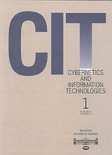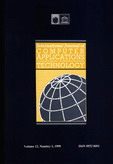
Cognitive Computation
metrics 2024
Advancing the Frontiers of Cognitive Science and Computation
Introduction
Cognitive Computation is a prominent journal published by Springer, focusing on interdisciplinary research at the intersection of cognitive sciences and computational methods. With an ISSN of 1866-9956 and an E-ISSN of 1866-9964, this journal has established itself as a leading resource for novel advancements and methodologies from 2009 through 2024. It is categorized in the top quartile (Q1) for 2023 in influential fields such as Cognitive Neuroscience, Computer Science Applications, and Computer Vision and Pattern Recognition. With impressive Scopus rankings including a 14th position in Cognitive Neuroscience and a percentile rank of 88th, the journal serves as a crucial platform for researchers and professionals eager to explore the cognitive processes underlying computational techniques. Although it does not operate under an open access model, the richness of research published within its pages contributes significantly to the academic discourse in these rapidly evolving domains, making it an essential read for scholars and practitioners alike.
Metrics 2024
 1.18
1.18 4.30
4.30 4.00
4.00 67
67Metrics History
Rank 2024
Scopus
IF (Web Of Science)
JCI (Web Of Science)
Quartile History
Similar Journals

CAAI Transactions on Intelligence Technology
Exploring New Horizons in Intelligent SystemsCAAI Transactions on Intelligence Technology is a premier peer-reviewed journal published by WILEY, dedicated to advancing the fields of Artificial Intelligence, Computer Networks and Communications, Computer Vision and Pattern Recognition, Human-Computer Interaction, and Information Systems. Since its inception in 2017, this Open Access journal has rapidly ascended the ranks, achieving Q1 quartile status across multiple categories as of 2023, and is recognized for its rigorous standards and innovative research dissemination, evidenced by impressive Scopus rankings, including Rank #12 in Computer Vision and Pattern Recognition. Through its commitment to providing a platform for high-quality research, the journal invites contributions from scholars globally, fostering a collaborative environment that stimulates intellectual exchange and encourages advancements in intelligent technology. Addressed to researchers, professionals, and students alike, CAAI Transactions on Intelligence Technology serves as a vital resource for those aiming to stay at the forefront of technological innovation.

Big Data and Cognitive Computing
Advancing Knowledge in Data-Driven Technologies.Big Data and Cognitive Computing is a premier open-access journal published by MDPI, dedicated to advancing research in the dynamic fields of artificial intelligence, computer science, information systems, and management information systems. Since its inception in 2017, the journal has established a significant presence, reflected in its impressive categorization within the Q2 quartiles for multiple disciplines in the 2023 rankings. Situated in Switzerland, the journal provides a vital platform for researchers, professionals, and students to publish groundbreaking work and access high-quality articles, enhancing the exploration of big data applications powered by cognitive computing. With an increasing global emphasis on data-driven decision-making, Big Data and Cognitive Computing offers unrestricted access to innovative research findings, addressing both theoretical and practical aspects. The journal's contributions are integral for those looking to stay at the forefront of technological advancements and their implications across various sectors.

Cybernetics and Information Technologies
Bridging Disciplines in Cybernetics and Computer ScienceCybernetics and Information Technologies is a pivotal academic journal, published by the Institute of Information and Communication Technologies at the Bulgarian Academy of Sciences. With its Open Access policy established since 2012, this journal facilitates wide dissemination of cutting-edge research across the field of computer science, particularly in the intersections of cybernetics and information technology. Indexed in Scopus, it holds a commendable position within the Q3 quartile for 2023, ranking #103 of 232 in the category of General Computer Science, placing it within the 55th percentile and attesting to its growing influence among peer publications. The journal not only aims to publish high-quality research but also seeks to foster a collaborative platform for academicians, practitioners, and students to advance the domain of computational technologies. With a focus on innovative methodologies and applications, Cybernetics and Information Technologies remains committed to addressing current challenges and exploring the future landscape of technology and information systems.

INTERNATIONAL JOURNAL OF COMPUTER APPLICATIONS IN TECHNOLOGY
Fostering knowledge and innovation in computer networks and communications.International Journal of Computer Applications in Technology is a reputable academic journal published by InderScience Enterprises Ltd, dedicated to advancing the field of computer applications across various domains including Computer Networks and Communications, Computer Science Applications, and more. With an ISSN of 0952-8091 and an E-ISSN of 1741-5047, this journal has been a credible source of research since its inception in 1976, transitioning into its current form in 1988. With its consistent rank in the Q3 quartile for several key engineering and computer science categories in 2023, it highlights the significance of the journal and its contributions to ongoing discourse in these fields. Researchers benefit from its wide-ranging scope, which encompasses both theoretical and practical applications of technology, making it an invaluable resource for both industry professionals and academic scholars. Although it currently does not provide open access, the journal remains committed to disseminating high-quality research that is essential for technological advancement and innovation.

INTELLIGENCE
Exploring the Depths of Intelligence and LearningINTELLIGENCE, published by Elsevier Science Inc, is a leading international journal dedicated to advancing research in the fields of cognitive psychology, developmental psychology, and human intelligence. With an impact factor reflecting its authority within the academic community, this journal occupies a prestigious position—ranking in the Q1 category for Arts and Humanities and achieving strong Q2 rankings in both Developmental and Educational Psychology and Experimental and Cognitive Psychology. Scholars can access high-quality research articles that contribute to the understanding of intelligent behavior, cognitive processes, and the implications of intelligence in various contexts. By encompassing a broad range of interdisciplinary perspectives since its inception in 1977 and continuing into 2024, INTELLIGENCE serves as an essential resource for researchers, professionals, and students keen to explore the complexities of human thought and learning.

IMAGING SCIENCE JOURNAL
Advancing the Frontiers of Imaging ScienceImaging Science Journal, published by Taylor & Francis Ltd, serves as a vital resource for researchers and professionals in the fields of computer vision, pattern recognition, and media technology. With an ISSN of 1368-2199 and an E-ISSN of 1743-131X, this journal has been fostering scholarly dialogue since its inception in 1997, with a converged content offering extending through 2024. Its categorization in Quartile 4 in Computer Vision and Pattern Recognition and Quartile 3 in Media Technology highlights its relevance and contributions to emerging trends in these domains. Although it ranks 36th in the Engineering - Media Technology category and 96th in Computer Science - Computer Vision and Pattern Recognition, its innovative research and insights continue to attract the attention of scholars dedicated to advancing knowledge at the intersection of imaging technologies. Offering versatile access options, this journal is essential for students, researchers, and professionals aiming to stay informed and engaged in the rapidly evolving landscape of imaging science.

INTERNATIONAL JOURNAL OF PATTERN RECOGNITION AND ARTIFICIAL INTELLIGENCE
Elevating Knowledge in Computer Vision and Machine LearningINTERNATIONAL JOURNAL OF PATTERN RECOGNITION AND ARTIFICIAL INTELLIGENCE, published by WORLD SCIENTIFIC PUBL CO PTE LTD, is a prestigious academic journal established in 1995 that serves as a critical platform for disseminating innovative research in the rapidly evolving fields of artificial intelligence, pattern recognition, and computer vision. With a focus on advancing theoretical and applied methodologies, the journal aims to bridge the gap between research and practical applications, making it essential reading for researchers, professionals, and students alike. The journal holds strong rankings within its categories, placing it in the Q4 for Artificial Intelligence, Q3 for Computer Vision and Pattern Recognition, and Q3 for Software as of 2023. Despite its growing influence, it continues to provide a rich resource for studies at the intersection of machine learning and computer science. The INTERNATIONAL JOURNAL OF PATTERN RECOGNITION AND ARTIFICIAL INTELLIGENCE not only contributes to academic discourse but also acts as a catalyst for technological advancement, making a significant impact on the scientific community.

Intelligent Decision Technologies-Netherlands
Fostering Interdisciplinary Insights in AI and Computer Vision.Intelligent Decision Technologies-Netherlands, published by IOS PRESS, is an emerging journal dedicated to the dynamic fields of Artificial Intelligence, Computer Vision, and Human-Computer Interaction. Established in 2007 and continuing through 2024, this journal aims to foster interdisciplinary research and innovation by providing a platform for cutting-edge studies and applications of intelligent systems. While its current impact factor reflects a growing influence within the scientific community, with quartile rankings ranging from Q3 to Q4 in various pertinent disciplines, Intelligent Decision Technologies plays a pivotal role in shaping future research directions. Although the journal does not offer open access, it remains accessible across academic institutions, encouraging researchers, professionals, and students to contribute to and engage with the latest advancements in decision technologies. With a commitment to quality and relevance, this journal seeks to advance knowledge and enhance the understanding of intelligent systems in today's rapidly evolving technological landscape.

Computational Visual Media
Elevating research standards in AI and computer graphics.Computational Visual Media, published by TSINGHUA UNIVERSITY PRESS, is a premier open access journal dedicated to advancing the fields of Artificial Intelligence, Computer Graphics and Computer-Aided Design, and Computer Vision and Pattern Recognition. Since its inception in 2015, it has established a robust position within the academic community, consistently achieving Q1 rankings across its categories as of 2023. With exceptional Scopus rankings, including a remarkable percentile standing in the top 10% globally, the journal serves as a vital resource for researchers, professionals, and students eager to explore cutting-edge methodologies and technologies in computational visual media. The journal’s open access format enhances accessibility, fostering global collaboration and dissemination of knowledge, making it an indispensable platform for those at the forefront of innovation in these dynamic fields. The journal is headquartered in Beijing, China, and aims to publish high-quality research that not only contributes to theoretical advancements but also addresses practical challenges within computational visual technologies.

Big Data Mining and Analytics
Advancing Knowledge Through Data InnovationBig Data Mining and Analytics, published by TSINGHUA UNIVERSITY PRESS, stands at the forefront of interdisciplinary research in the fields of Artificial Intelligence, Computer Networks and Communications, Computer Science Applications, and Information Systems. With an impressive Q1 ranking in multiple categories as of 2023, this journal serves as a critical platform for researchers and professionals eager to explore innovative techniques and methodologies related to big data analytics. Since its transition to Open Access in 2018, Big Data Mining and Analytics has aimed to increase the visibility and accessibility of its cutting-edge research, making permanent strides in the global academic landscape. Housed in Beijing, China, and actively embracing the converged years from 2018 to 2024, the journal aims to cultivate a rich discourse on emerging trends and applications, ensuring its relevance in a rapidly evolving technological environment. Join a vibrant community of scholars dedicated to advancing the frontiers of knowledge in big data.